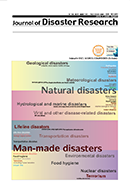16 巻, 1 号
選択された号の論文の15件中1~15を表示しています
- |<
- <
- 1
- >
- >|
Special Issue on COVID-19 and Historical Pandemics
-
原稿種別: Editorial
2021 年16 巻1 号 p. 5
発行日: 2021/01/30
公開日: 2021/01/30
PDF形式でダウンロード (185K) -
原稿種別: Material
2021 年16 巻1 号 p. 6-11
発行日: 2021/01/30
公開日: 2021/01/30
PDF形式でダウンロード (292K) -
原稿種別: Note
2021 年16 巻1 号 p. 12-15
発行日: 2021/01/30
公開日: 2021/01/30
PDF形式でダウンロード (916K) -
原稿種別: Note
2021 年16 巻1 号 p. 16-23
発行日: 2021/01/30
公開日: 2021/01/30
PDF形式でダウンロード (393K) -
原稿種別: Paper
2021 年16 巻1 号 p. 24-30
発行日: 2021/01/30
公開日: 2021/01/30
PDF形式でダウンロード (417K) -
原稿種別: Paper
2021 年16 巻1 号 p. 31-39
発行日: 2021/01/30
公開日: 2021/01/30
PDF形式でダウンロード (461K) -
原稿種別: Note
2021 年16 巻1 号 p. 40-47
発行日: 2021/01/30
公開日: 2021/01/30
PDF形式でダウンロード (321K) -
原稿種別: Paper
2021 年16 巻1 号 p. 48-55
発行日: 2021/01/30
公開日: 2021/01/30
PDF形式でダウンロード (1012K) -
原稿種別: Note
2021 年16 巻1 号 p. 56-60
発行日: 2021/01/30
公開日: 2021/01/30
PDF形式でダウンロード (238K) -
原稿種別: Review
2021 年16 巻1 号 p. 61-69
発行日: 2021/01/30
公開日: 2021/01/30
PDF形式でダウンロード (2303K) -
原稿種別: Review
2021 年16 巻1 号 p. 70-83
発行日: 2021/01/30
公開日: 2021/01/30
PDF形式でダウンロード (778K) -
原稿種別: Survey Report
2021 年16 巻1 号 p. 84-87
発行日: 2021/01/30
公開日: 2021/01/30
PDF形式でダウンロード (257K) -
原稿種別: Review
2021 年16 巻1 号 p. 88-96
発行日: 2021/01/30
公開日: 2021/01/30
PDF形式でダウンロード (2811K) -
原稿種別: Review
2021 年16 巻1 号 p. 97-109
発行日: 2021/01/30
公開日: 2021/01/30
PDF形式でダウンロード (2864K) -
原稿種別: Review
2021 年16 巻1 号 p. 110-117
発行日: 2021/01/30
公開日: 2021/01/30
PDF形式でダウンロード (216K)
- |<
- <
- 1
- >
- >|
